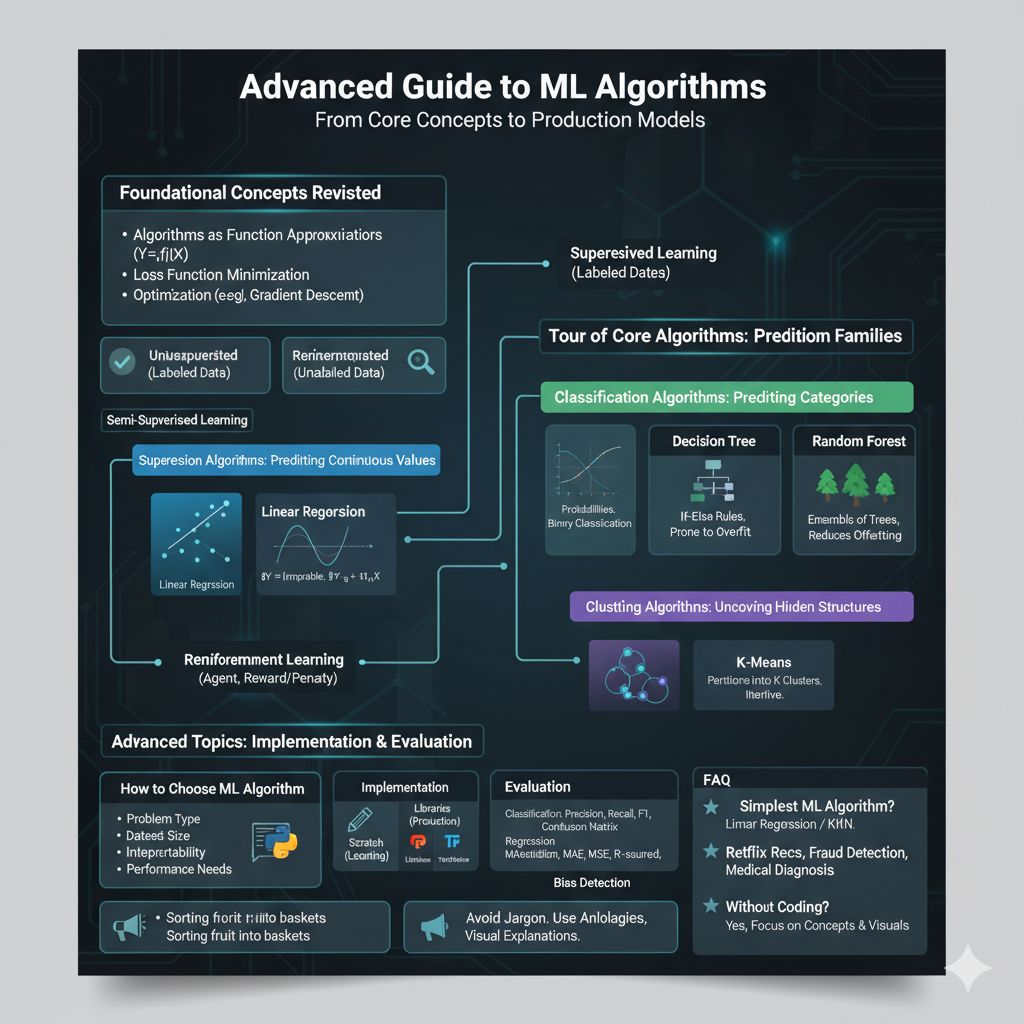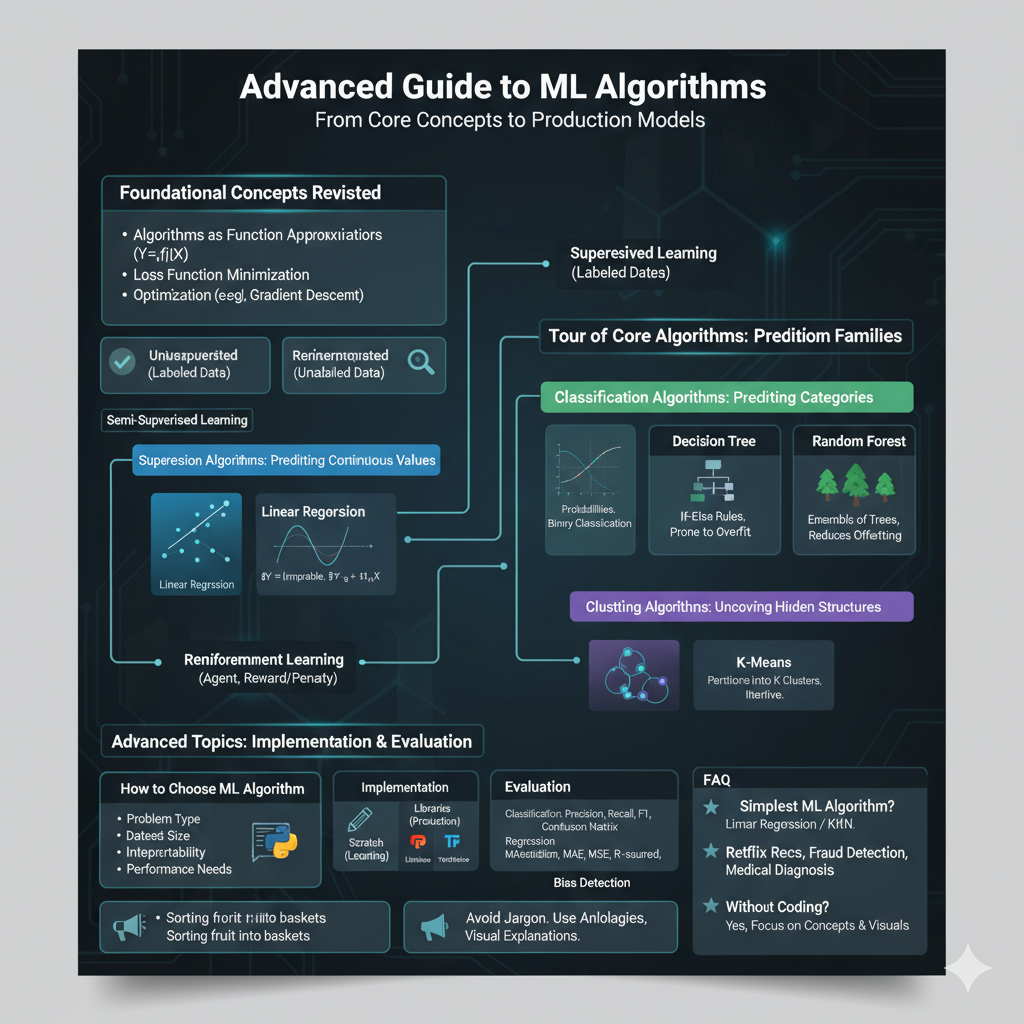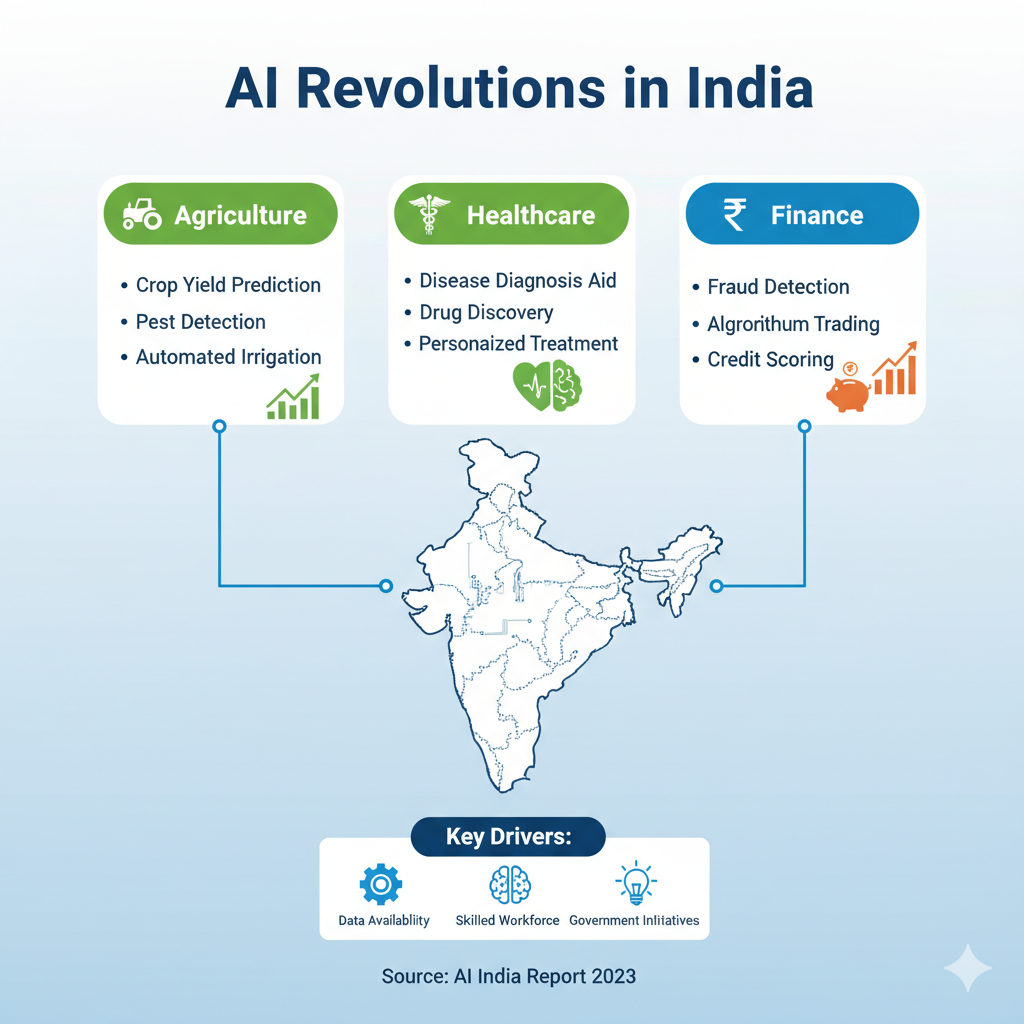If you’ve moved past the initial learning curve and are now looking to master the art and science of machine learning, this guide is for you. We won’t just define algorithms; we’ll dissect their nuances, explore the trade-offs, and provide a framework for thinking like a seasoned ML practitioner. This is more than a simple beginner’s guide to machine learning algorithm theory; it’s a deep dive into practical application and advanced understanding.
We’ll journey through the core logic, showing you not just what to use, but why you should use it. Let’s start by demystifying the foundational building blocks.
*Foundational Concepts Revisited: A Deeper Perspective
Even experts benefit from revisiting the basics. Understanding the core principles is crucial before building your first machine learning model that truly performs.
*How Do Machine Learning Algorithms Work for Beginners and Experts Alike?
At its heart, an algorithm is a procedure for turning data into insight. For a deeper understanding, think of it as a function approximator. You provide input data (X) and, in many cases, output data (Y), and the algorithm’s job is to learn the mapping function Y = f(X). The core process involves minimizing a loss function—a measure of how wrong the model’s predictions are—through an optimization process like gradient descent. This is the simple explanation of ml algorithms that holds true from linear regression to complex neural networks.
*Supervised vs Unsupervised Learning Explained Simply, But with Nuance
You know the basics: supervised learning uses labeled data, while unsupervised learning finds patterns in unlabeled data. But the advanced perspective lies in the gray areas. Semi-supervised learning leverages a small amount of labeled data with a large amount of unlabeled data. Reinforcement learning trains an agent to make decisions by rewarding or penalizing its actions. The choice between them is the first critical step in any project.
This clear distinction is one of the key concepts of machine learning algorithms that guides your entire workflow.
*A Tour of Core Algorithm Families
Let’s move beyond basic definitions.
We’ll explore the most common algorithm families, focusing on their practical strengths and weaknesses. This is a curated list of the most important ml algorithms to learn first for any serious practitioner.
*Regression Algorithms: Predicting Continuous Values
When your target variable is a number—like price, temperature, or sales volume—you turn to regression.
*Linear Regression Algorithm Explained for Beginners and Beyond
While it’s often the easiest machine learning algorithm to implement, its power shouldn’t be underestimated. Linear Regression assumes a linear relationship between input features and the output variable. Its strength is its interpretability. The coefficients of the model tell you exactly how much the output is expected to change for a one-unit change in each input feature, holding all other features constant. This makes it a great tool for inference, not just prediction, and one of the best simple regression algorithms for beginners.
*Classification Algorithms: Predicting Categories
From spam detection to medical diagnosis, classification is a cornerstone of machine learning.
*Logistic Regression for Beginners Python Implementation
It’s fast, interpretable, and provides a good baseline model for any classification problem. It’s a fundamental part of our machine learning algorithms for classification problems toolkit.
*Decision Tree vs Random Forest Explained
A decision tree algorithm explained for beginners is often shown as a simple flowchart of if-then-else conditions. It’s highly interpretable but prone to overfitting.
This is where the Random Forest comes in. A random forest algorithm simple explanation is that it’s an ensemble of many decision trees. By averaging their predictions, it reduces overfitting and generally achieves higher accuracy, making it one of the most common machine learning algorithms used today. For more on the theory behind it, see the foundational work by Leo Breiman on Google Scholar.
*Introduction to Support Vector Machines (SVM) for Beginners
SVMs work by finding the optimal hyperplane that best separates data points of different classes in a high-dimensional space. They are particularly effective in high-dimensional spaces and are memory efficient, but can be slow on very large datasets.
*Clustering Algorithms: Uncovering Hidden Structures
When you have no labels, clustering helps you find natural groupings in your data.
*K-Means Clustering Algorithm Step by Step Guide
K-Means is the workhorse of clustering. It partitions data into ‘K’ distinct, non-overlapping clusters. The algorithm is iterative: it assigns each data point to the nearest cluster centroid and then recalculates the centroids. It’s simple and fast, making it a great starting point for any clustering algorithms for beginners comparison.
*Advanced Topics: From Implementation to Evaluation
Knowing the theory is one thing; applying it is another. Let’s talk about the practical side of machine learning.
*How to Choose a Machine Learning Algorithm for a Project
There’s no single best model. The right choice depends on:
- Problem Type: Regression, classification, or clustering?
- Dataset Size: Some algorithms, like SVMs, struggle with very large datasets.
- Interpretability: Do you need to explain the model’s decisions? If so, a decision tree or linear regression is better than a complex neural network.
- Performance Needs: What’s the accuracy requirement? How fast does it need to be?
Avoid common mistakes when choosing an ml algorithm, like always reaching for the most complex tool. Start simple, establish a baseline, and iterate. The Scikit-learn documentation provides a helpful flowchart for this process. You can view it on their official site: Choosing the right estimator.
*Implementing ML Algorithms from Scratch for Beginners vs. Using Libraries
While it’s a valuable learning exercise to code algorithms from scratch, in a professional setting, you’ll use libraries. A scikit-learn algorithms for beginners tutorial is often the best place to start. Libraries like Scikit-learn and TensorFlow are optimized, tested, and provide a standardized interface for building models. This is central to any practical machine learning with python for beginners course.
*How to Evaluate a Machine Learning Model for Beginners
For classification, don’t just use accuracy. Look at precision, recall, F1-score, and the confusion matrix, especially for imbalanced datasets. For regression, use Mean Absolute Error (MAE), Mean Squared Error (MSE), and R-squared. Understanding machine learning bias for beginners and experts alike is critical here; a model can be accurate but biased and unfair in its predictions.
*Communicating Your Results Effectively
Your job isn’t done when the model is built. You need to communicate its value.
*How to Explain Machine Learning Algorithms to a Non-Technical Audience
This is a crucial skill. Avoid jargon. Use analogies. A visual explanation of machine learning algorithms is often most effective. For instance, explaining a classification model as a machine that sorts fruit into different baskets (apples, oranges, bananas) based on features like color, shape, and size. This is how you bridge the gap and make machine learning for business professionals guide their decisions.
*Final Thoughts: Your Path Forward
We’ve covered a lot of ground, from the fundamentals to the practicalities of choosing, implementing, and evaluating models. The journey in machine learning is one of continuous learning. The best machine learning algorithm for beginners to learn is the one that solves your problem effectively and that you understand deeply. Start a machine learning project for beginners step-by-step to solidify these concepts.
For those looking to explore the cutting edge, an introduction to neural networks for beginners is a great next step, particularly with papers like “Attention Is All You Need,” which revolutionized fields like natural language processing.
*Frequently Asked Questions (FAQ)
Here are answers to some common questions we see from aspiring data scientists.
*⭐ What is the simplest machine learning algorithm?
The simplest is arguably Linear Regression for regression tasks and K-Nearest Neighbors (KNN) for classification. Both are based on very intuitive concepts, making them easy to understand and implement.
*⭐ What are some real-world examples of machine learning algorithms?
Netflix’s recommendation system uses algorithms to suggest movies. Banks use algorithms to detect fraudulent transactions. In healthcare, they are used to diagnose diseases from medical images. These are all real-world examples of machine learning algorithms in action.
*⭐ Can I start understanding machine learning algorithms without coding?
Absolutely. Understanding machine learning algorithms without coding is possible by focusing on the core concepts, logic, and a visual explanation of machine learning algorithms. Many resources use analogies and diagrams to explain how they work before you ever write a line of code.
*⭐ Which ml algorithm to use for prediction of stock prices?
A machine learning algorithm for predicting stock prices for beginners is often a time-series model like ARIMA or an LSTM (a type of neural network). However, this is a very difficult problem due to the noisy and unpredictable nature of financial markets.
*⭐ What is the best classification algorithm for beginners?
Logistic Regression, K-Nearest Neighbors (KNN), and Decision Trees are excellent starting points. They represent different approaches to classification and provide a solid foundation.
*⭐ How do you handle a machine learning algorithm for text classification for beginners?
A classic approach is to use a technique called TF-IDF (Term Frequency-Inverse Document Frequency) to convert text into numerical vectors, and then apply a simple classification algorithm like Naive Bayes or Logistic Regression. This is a common starting point in a machine learning algorithm for text classification for beginners tutorial.
*⭐ Is there a machine learning algorithm cheat sheet for beginners?
Yes, many exist. Scikit-learn, SAS, and other organizations provide excellent cheat sheets that summarize the strengths, weaknesses, and use cases of various algorithms in a single view. They are a great reference.
*⭐ What is the first step in how to start learning machine learning algorithms?
The first step is to learn the fundamentals of Python and key libraries like NumPy and Pandas. Then, focus on understanding the three main categories of ML: supervised, unsupervised, and reinforcement learning. From there, you can dive into your first algorithm, usually linear regression.




